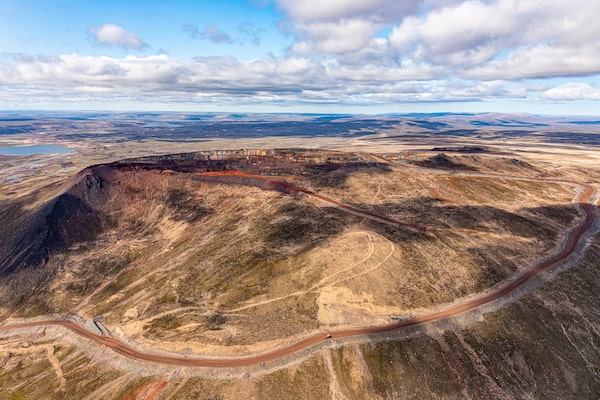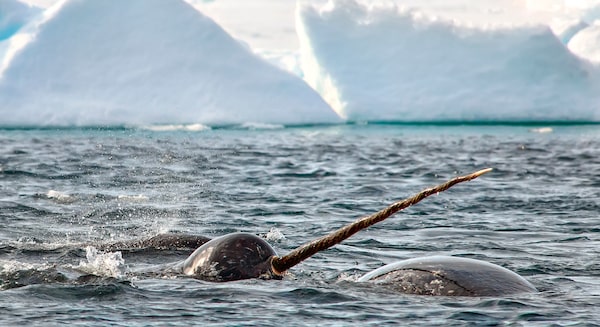Mary River iron ore on Baffin Island, Nunavut.Mike Pike/Baffinland Iron Mines
A proposed iron ore mine expansion by Baffinland Iron Mines Corporation is raising environmental red flags among Inuit groups, hamlets, and subsistence hunters and trappers, potentially putting the brakes on one of the biggest industrial developments ever envisaged in the Canadian Arctic.
Privately held Baffinland hopes to double its production of iron ore at its Baffin Island mine in Nunavut to 12 million tonnes a year, from six million tonnes. The Oakville, Ont.-based miner also wants to build a railroad that would transport ore from its Mary River mine in the Qikiqtani region of North Baffin to Milne Port, about 100 kilometres away.
Baffinland says the expansion is crucial to make the mine sustainable and profitable in the long term. By boosting production, the company will also be able to cash in on buoyant iron ore prices. The commodity’s main use is in the production of steel, and lately Chinese production has been brisk as its economy stages a rebound from the COVID-19 pandemic. Baffinland is owned by U.S. private equity group The Energy and Minerals Group and giant Luxembourg-based steel producer ArcelorMittal.

Baffinland wants to build a railroad that would transport ore from its Mary River mine to the Milne Port.Baffinland Iron Mines/Handout
Last week, a final round of public hearings on the potential environmental impact of the expansion of Mary River began in Nunavut, where the key Inuit stakeholders are presenting to the Nunavut Impact Review Board (NIRB) and questioning Baffinland about its plans.
Apart from a small section of a supply road on which Baffinland currently transports the ore, the entire operations are situated on Inuit-owned land. The Inuit secured ownership as part of a historic land-settlement agreement with the federal government in 1993, which laid the foundation for the formation of Nunavut six years later.
In the territory, the hunting and trapping of wildlife and marine mammals, including caribou, seals and whales, has been a way of life for Indigenous people here for thousands of years, providing sustenance, food and clothing. The Inuit are worried about the potentially damaging effect increased shipping of ore from Mary River through waterways will have on marine life, especially narwhal. They’re also concerned about the railway cutting into and damaging permafrost hunting grounds.
“The company basically admitted it won’t know for sure what impact this railroad will have on caribou until they build it,” said Jerry Natanine, mayor of the Baffin Island hamlet of Clyde River, which is opposed to the mine expansion.
“In some ways, they’re doing a big experiment with our environment.”
Several organizations representing hunters and trappers in the North Baffin region say there is already serious concern about damage the existing mine, which has been in operation since 2015, is having on the environment.
Eric Ootoovak, chair of the Mittimatalik Hunters and Trappers Organization (MHTO), said that iron ore dust from blasting at Mary River has spread for thousands of square kilometres. The residue is melting ice on seal hunting routes, and polluting waters used by hunters for drinking and cooking, he added. As well, he says ice breaking around the port, in combination with heavy traffic from Baffinland’s iron ore ships, have pushed marine life further out to sea, meaning Indigenous hunters must travel greater distances for food.
“The ecosystem is already very fragile,” he said.
“Baffinland hasn’t done a good job.”
Hunting and fishing access routes have been dramatically affected by increased snow melt due to the iron ore dust.Mittimatalik Hunters and Trappers Organization./Handout
The chief executive of Baffinland, Brian Penney, declined interview requests for this story.
A Baffinland representative e-mailed The Globe and Mail a number of documents detailing the company’s vision for the mine expansion and the projected economic benefits to the Inuit community.
In one of the documents, Baffinland said it plans to pay MHTO $1.3-million in compensation because of the negative impact its operations are having on Inuit hunting grounds. If the mine expansion gets the go-ahead, Baffinland said that Inuit organizations are projected to receive $2-billion in benefits, including land lease payments and royalties, over the next 16 years. The projections are based on assumptions about the future price of iron ore and so could vary significantly.
“Although the exact economic benefits for the territory are unknown at this point in time, it is fairly certain that the economy of Nunavut will benefit significantly from the Mary River Project,” the company said in a document.

An aerial view of the Mary River mine.Baffinland Iron Mines/Handout
The Mary River mine is one of only a handful of major mine developments in the Canadian Arctic. Agnico Eagle Mines Ltd. operates two gold mines in Nunavut, Meliadine and Amaruq in the Kivalliq district. TMAC Resources Inc. owns the Doris underground gold mine in Hope Bay. TMAC was recently sold to Agnico Eagle, after the federal government blocked the sale of the company to a Chinese state-owned company because of national security concerns.
Frank Tester, technical adviser for the hamlet of Pond Inlet, a mostly Inuit community of about 1,600 people on the northern end of Baffin Island, which is also opposed to the Baffinland expansion, cited the lack of reliable information about the likely impact of the mine expansion on the narwhal population.
Known as the unicorns of the sea because of the distinctive needle-like tusks of the male species, narwhal are found at the northern edge of Baffin Island from spring to fall. Increased shipping out of the port in the waters where the narwhal congregate has the community concerned. Mr. Tester said that Baffinland’s “adaptive management plan,” which is a strategy for dealing with the negative impact on the environment, is “seriously incomplete.”
“We have no idea on what this is going to look like,” he said.

Near Arctic Bay, Nunavut, narwhal are photographed May 22, 2011.MICHELLE VALBERG/The Globe and Mail
Baffinland uses a number of methods to monitor the impact of the current mining operation on narwhal population, including conducting aerial surveys. But Mr. Tester maintains that is a poor method to monitor populations and says that keeping track of the body fat composition of narwhal over a period of years, while much more time-consuming, is a much more accurate method.
The Qikiqtani Inuit Association (QIA), which represents a number of Inuit groups, hasn’t yet decided on whether it will grant its endorsement to the mine extension.
“Inuit remain deeply conflicted and concerned about whether a larger mine project, with all of the related shipping and rail activity, is really in the best interests of the community of Mittimatalik and other Inuit in the region,” QIA president P.J. Akeeagok said in his remarks to the NIRB at the hearings last week.
A number of Inuit groups presenting last week were also critical of the NIRB‘s hearing process, saying the regulator is severely curtailing the number of questions the Inuit can pose to Baffinland about the mine expansion, and that the format is culturally inappropriate.
“The process doesn’t give any attention to Inuit ways of doing things,” Mr. Tester said.
“They’re having imposed upon them an entirely white person’s way of going about things, which is confrontational sometimes and oppositional. It’s just so out of whack with the way Inuit deal with issues like this.”
Karen Costello, executive director of the NIRB, declined to comment on concerns about the format of the hearings.
The hearings are scheduled to run until Feb. 6. The NIRB has 45 days to send its recommendation to the federal Minister of Northern Affairs Dan Vandal. The minister will then have the final word on whether the expansion goes ahead.
Your time is valuable. Have the Top Business Headlines newsletter conveniently delivered to your inbox in the morning or evening. Sign up today.
 Niall McGee
Niall McGee